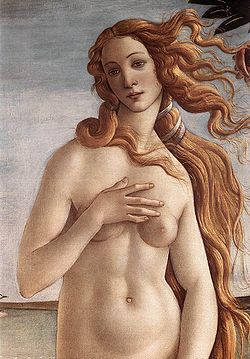
Aesthetic canon
Encyclopedia

Visual arts
The visual arts are art forms that create works which are primarily visual in nature, such as ceramics, drawing, painting, sculpture, printmaking, design, crafts, and often modern visual arts and architecture...
and aesthetics
Aesthetics
Aesthetics is a branch of philosophy dealing with the nature of beauty, art, and taste, and with the creation and appreciation of beauty. It is more scientifically defined as the study of sensory or sensori-emotional values, sometimes called judgments of sentiment and taste...
, or an aesthetic canon, is a rule for proportions
Body proportions
While there is significant variation in anatomical proportions between people, there are many references to body proportions that are intended to be canonical, either in art, measurement, or medicine....
, so as to produce a harmoniously formed figure.
Evolution
By extension, the norms of a certain epoch as to what is or is not considered beautiful may be called a canon of beauty. These norms have varied over time and what is considered beautiful in one era may not necessarily be so in another. Canons of beauty follow the evolution of fashionFashion
Fashion, a general term for a currently popular style or practice, especially in clothing, foot wear, or accessories. Fashion references to anything that is the current trend in look and dress up of a person...
and are dependent on the evolution of physical decoration techniques such as hairdressing or make up.
Under France's Ancien Régime, canons of beauty required a woman to have as white a skin as possible. This was achieved (sometimes to the danger of health) by rouge
Rouge (cosmetics)
Rouge , also called blush or blusher , is a cosmetic typically used by women to redden the cheeks so as to provide a more youthful appearance, and to emphasize the cheekbones....
and face powder
Face powder
Face powder is a cosmetic powder applied to the face to set a foundation after application. It can also be reapplied throughout the day to minimize shininess caused by oily skin. There is translucent sheer powder, and there is pigmented powder. Certain types of pigmented facial powders are meant...
s as well as 'mouches', fake moles made of black muslin glued onto the face or chest. Today, by contrast, such canons prefer a 'healthier' skin colour, sportiness, gait and so on.
According to the anthropologist Alfred-Louis Kroeber, the female silhouette regularly revolves through one of three basic shapes—bustle
Bustle
A bustle is a type of framework used to expand the fullness or support the drapery of the back of a woman's dress, occurring predominantly in the mid-to-late 19th century. Bustles were worn under the skirt in the back, just below the waist, to keep the skirt from dragging. Heavy fabric tended to...
, scabbard
Scabbard
A scabbard is a sheath for holding a sword, knife, or other large blade. Scabbards have been made of many materials over the millennia, including leather, wood, and metals such as brass or steel.-Types of scabbards:...
, bell
Bell (instrument)
A bell is a simple sound-making device. The bell is a percussion instrument and an idiophone. Its form is usually a hollow, cup-shaped object, which resonates upon being struck...
.
Proportions in art
For his painting The Birth of Venus Sandro BotticelliSandro Botticelli
Alessandro di Mariano di Vanni Filipepi, better known as Sandro Botticelli was an Italian painter of the Early Renaissance...
stated that the distance between the nipple and navel, between the two legs and between the navel and the groin must all be equal for a figure to (in his opinion) be ideally proportioned. Other such systems of 'ideal proportions' in painting and sculpture include the Polyclitean canon and Vitruvian module
Vitruvian module
A module is a term that was in use among Roman architects, corresponding to the semidiameter of the column at its base. The term was first set forth by Vitruvius , and was employed by architects in the Italian Renaissance to determine the relative proportions of the various parts of the Classical...
s, best known in the Vitruvian Man
Vitruvian Man
The Vitruvian Man is a world-renowned drawing created by Leonardo da Vinci circa 1487. It is accompanied by notes based on the work of the famed architect, Vitruvius. The drawing, which is in pen and ink on paper, depicts a male figure in two superimposed positions with his arms and legs apart and...
.

